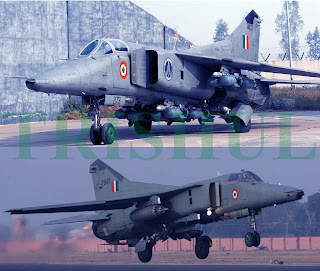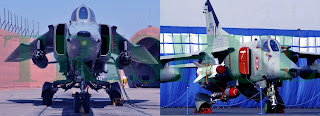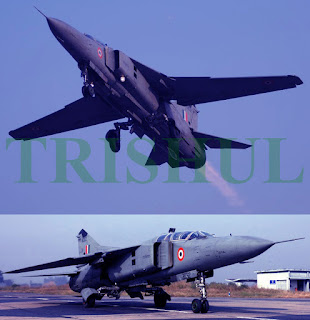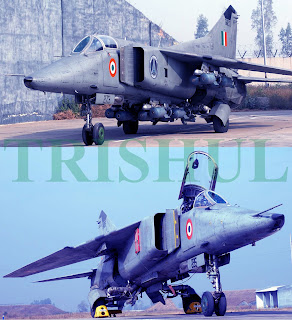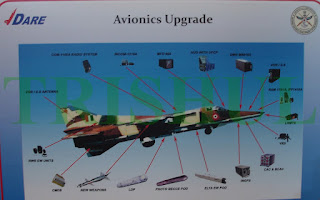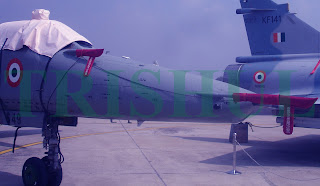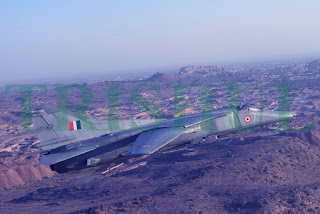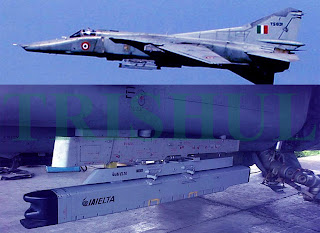The Indian Air Force’s (IAF) association with ‘swing-wing’ combat aircraft came to an end on December 27, 2019 when the last remaining seven MiG-27UPGs were decommissioned from service. These aircraft, along with the already decommissioned MiG-27Ms and MiG-23BNs, had been procured for serving as all-weather tactical interdiction platforms with eight IAF squadrons.
In all, 95 MiG-23BNs were delivered between late 1980 and late 1982 and they served with No.10 ‘Winged Dagger’. No.220 ‘Desert Tigers’ and No.221 ‘Valiants’ Sqns between January 1981 and March 6, 2009 and having flown more than 154,000 hours), with each carrying a 3-tonne weapons payload. The IAF subsequently began procuring 165 MiG-27Ms (however, only 125 of which were licence-built by Hindustan Aeronautics Ltd or HAL between 1986 and 1992) for equipping No.222 ‘Tiger Sharks; No.2 ‘Winged Arrows’, No.18 ‘Flying Bullets’, No.29 ‘Scorpions’, and No.22 ‘Swifts’ Sqns from October 1984 till May 2, 1992. Each MiG-27M could haul a 4-tonne weapons payload. Of these, 40 were subsequently upgraded to MiG-27UPG standard—the upgrade work involving only the mission avionics suite. Latter batches of HAL-built MiG-27Ms had 74% local industrial content.
While the MiG-23BNs all came from Irkutsk Aviation Production Association (IAPA), for the MiG-27M licenced-production programme, a team of specialists from both IAPA and Mikoyan OKB worked in Nashik for the entire second half of 1982. In the first phase, the initial batch of MiG-27Ms were delivered from Irkutsk in semi-knocked-down condition (they were partially dismantled for transportation by sea). In the second phased, fully knocked-down kits were delivered for final assembly by HAL. The first locally-assembled MiG-27M was rolled out in October 1984. And on January 11, 1986, the first MiG-27M-equipped squadron (No.222 ‘Tiger Sharks’) of the IAF had achieved full operational status.
The MiG-27M licenced-production programme was divided into four phases, with Phase-1 involving the final assembly of aircraft that had been delivered in semi-knocked-down condition, Phases-2 and -3 involving the final-assembly of aircraft that had arrived in fully-knocked-down condition, and Phase-4 involving the supply from the USSR of only materials, sheet duralumin, forgings and blanks, which were all machined by HAL with the help of numerically controlled machines procured by HAL from Western European countries.
While the airframes of both the MiG-23BN and MiG-27M had a total technical service life (TTSL) of 3,000 flight-hours, the airframe developer—Mikoyan OKB—had subsequently certified both airframes for an additional 1,200 flight-hour service-life. However, if the airframes were to be subjected to total refurbishment by HAL, then the service-life could be increased by another 3,000 flight-hours based on structural fatigue tests that could have been carried out by the National Aerospace Laboratories (NAL).
However, an engine-change was called for and Mikoyan OKB along with Moscow Machine-building Production Company (MMPP Salyut) had by the late 1990s had proposed that the Tumansky R29-300 and R29B-300 turbofans be replaced with AL-31F turbofans that offered 1-tonne maximum extra thrust-rating. This was accepted in-principle by the IAF.
In parallel, the Defence R & D Organisation’s (DRDO) Defence Avionics Research Establishment (DARE) began a deep-upgrade of the MiG-27M’s avionics suite in 2002. Only 40% of the on-board systems, mainly of the mechanical type, were retained as original factory equipment of Russian design. The first prototype MiG-27UPG flew on March 25, 2004, followed by a second prototype on November 4, 2004. Together, during their flight-trials, they flew more than 300 hours.
In June 2006, came the MiG-27UPG’s Initial Operational Clearance (IOC) certification from IAF HQ. It opened the way for work on aircraft building. After modernization, they equipped two squadrons. Modified cars received the designation MiG-27UPG.
Back in 2003, Vladimir Labazin, MMPP Salyut’s Deputy Chief Designer, described how the re-engining of MiG-23UBK tandem-seat operational conversion trainers, the MiG-23BN and MiG-27M with AL-31F turbofans could have been achieved. “Having taken stock of our capabilities, we realised that we could cough up some funds to invest into the initial-stage assessment of mounting the AL-31F. Our design bureau began looking into this in late 2002. Aircraft and engine dimensional analysis and computerised, visual and assembly coordination showed that minor airframe and engine modifications would make them compatible in terms of size. The aircraft features some room for improvement as far as airflow is concerned and we can reduce the AL-31F’s takeoff airflow a little while maximising airflow at high altitude. Early mechanical problems have already been overcome.”
“For example, the AL-31F used to keep setting against the fuel tank or some other structural elements and we had to modify the positions of some components for the engine to fit in. To keep aircraft systems intact, MMPP Salyut, retained all aircraft accessories mounted on the R29B-300’s reduction gear, with only the accessory gearbox replaced–the gear ratio of the old engine was different, so we had to replace the reduction gear. However, even though we have retained all aircraft accessories, we had to rearrange them to avoid altering the airframe and engine nacelle’s inner mould lines, fuel tanks and heavy frames.
In addition, introduction of advanced engine mounting components, re-arrangement of the accessories, generator and starter unit, and modification of the dimensions of certain engine components enabled us to squeeze the AL-31F into the nacelle without disturbing primary structural and fuel system elements of the aircraft.
During the spring and summer of 2003, MMPP Salyut developed the mock-up of the AL-31F, and after exhaustive tests conducted the final fitting. “We are planning to manufacture the engine by year-end and launch its bench tests in January 2004, and count on doing flight tests in July or August 2004. After this has been completed, we will commence full-scale improvement of the IAF’s MiG-27Ms to begin with.
To avoid redesigning the load-bearing structure of the airframe fuel cells, MMPP Salyut’s designers came up with a new load-bearing element—a longitudinal beam—that mounted the main attach fitting for the AL-31F. In addition, an extra engine attach fitting was introduced to the rear fuselage to fix the AL-31F relative to the axis, thus ensuring necessary thermal movement. Engine mounting procedures too were altered. The R29B-300 comprised two parts. The fore part was first to be mounted, then the aft one, after which both would be put together.
The AL-31F is a single-piece design and therefore it has to be installed into the fuselage mid-section, with the tail section to follow. To this end, a dedicated trolley was made, on which the AL-31F rolled into the fuselage, was then attached to main bracket supports and aligned with the aircraft’s centreline and was then fixed in this position with a dedicated rod on the fore end of the AL-31F.
Then the tail section was rolled on to the AL-31F using the dedicated trolley and linked with the mid-section. The AL-31F was then aligned with the tail bumper and detaching the hoist fitting. Then all systems were assembled. In addition, minor modifications to the aircraft had to be introduced. For example, the starter had to be rotated 200 degrees with a new exhaust shutter made, and new air ducts installed to cool the assemblies. Main modifications were made to the AL-31F. To reduce costs and time, the new accessory gearbox was made of two sections. Aircraft accessory elements were ‘borrowed’ from the previous R29 and the engine’s portion from the AL-31F. Both parts of the gearbox were linked by virtue of the new reduction gear and the casing. The engine oil system was revamped drastically because the oil tank and the oil pump pack had to be positioned where there was room to house them instead of where it was best for the engine.
Fitting the AL-31F on to the IAF’s MiG-23UBKs, MiG-23BNs and MiG-27M would have had another benefit: if those aircraft were to be discarded from service before their engines’ service-life had expired, then 70% of their components could be used for overhauling the AL-31FPs now powering the IAF’s Su-30MKI H-MRCAs. And that is because the core portions of the AL-31F and AL-31FP are identical, with only their outer componentry—casings, oil systems and outer plumbing and wiring— having been modified.
Deliveries of AL-31Fs to power the MiG-23UBKs, MiG-23BNs and MiG-27Ms were scheduled to kick off as early as the first quarter of 2005. However, to everyone’s consternation, the re-engining contract was not inked and the IAF decided not to re-engine the MiG-23UBKs, MiG-23BNs and MiG-27Ms. So, what were the consequences of this decision?
The IAF lost 13 of its MiG-27Ms aircraft between 2001 and 2016. In the last 10 years, 11 MiG-27Ms, have crashed. Subsequent boards of inquiry shockingly revealed that majority of the MiG-27Ms went down because of “engine-related technical defects” like perennial engine oil leaks from ill-serviced fuel-pumps of the R29B-300 turbofans. Nearly 40% of these turbofans and related accessories licence-produced by HAL’s Koraput Division had to be returned by the IAF for some or the other defects. The problems ranged from oil leaks, metallic particles in oil filters and hot-air leaks from rear casings to troubles in compressor-blades and even in the turbines.
Most of the cause factors can be classified as defects during manufacturing or overhauling processes. The MiG-27M suffered Low-Pressure Turbine Rotor (LPTR) failures in at least 11 incidents. HAL in some cases even lied while overhauling the LPTR, saying that it had followed the overhaul manual, but subsequent IAF investigations revealed that the procedure recommended by the original equipment manufacturer (OEM) was not being implemented by HAL. Such lapses had also led to previous crashes of MiG-21 Bisons. The springs installed in the fuel pump of the MiG-21 Bison’s R25-300 turbofans were failing frequently. A MiG-21 Bison crashed in November 2012 in Gujarat, which was attributed to spring failure. Of the five main fuel-pumps fitted with HAL-manufactured springs, at least three springs failed, which is unforgivable as it would have certainly resulted in accidents. Shockingly, the main fuel pumps of the MiG-21 Bison continue to leak fuel, despite four studies conducted and implemented since the 1990s. Despite incorporating changes, fuel leak from the main fuel-pump has continued unabated from throttle-end.
However, another reason behind the poor quality of production and engine repairs is attributed to mass production work in the last leg of a production year in order to achieve the projected target. For example, in the first six months of 2012-2013 production year, HAL finished overhaul work on only four RD-33 turbofans of the MiG-29B-12, but in the last quarter of the year, four RD-33 were completely overhauled within three months. Similarly for the R29B-300s, HAL finished overhauling nine engines in nine months, but interestingly another nine engines were completed within the last three months. The issue was flagged by the IAF, saying that such industrial productivity trends were adversely affecting the quality of overhauled turbofans.
Thus, it appears that HAL was not interested in providing quality turbofans to the IAF and instead was only interested in meeting the production numbers every year. There is also an impression that the workforce in HAL deliberately delayed the production to last three months to earn few extra bucks for ‘overtime’ perks, which is disgusting, given the fact that human lives are at stake. Interestingly, throughout their service-lives, none of the MiG0-23BNs, which had come off-the-shelf from IAPA, displayed any engine-related equipment malfunctions!
The end-result: premature decommissioning of the IAF’s MiG-23UBKs, MiG-23BNs and MiG-27Ms, thereby denying the IAF another eight operational combat squadrons.
